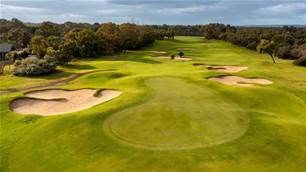When you have been sitting on a plane for two hours, the first movie has been watched, you’re into your second in-flight snack and the flight tracker map shows you’re not quite halfway, there is a realisation Perth is a long way away.
One of Perth’s most underrated courses lies in the heart of the city’s southern suburbs.
Gosnells Golf Club, at Canning Vale, plays much like a Sandbelt course with plenty of bunkering, undulating terrain and interesting green complexes.
Graham Marsh played much of his early golf at Gosnells and even won a handicap championship here as a teenager. Of course, he went on to become one of Australia’s best professionals in the 1970s and 80s winning more than 70 tournaments around the world.
He returned to the course in the mid-1990s, not to play but to redesign the layout as part of a course masterplan following the renovation of the clubhouse.
It is easy to draw comparisons with the Sandbelt here. The course generally plays firm and fast, the bunkering is plentiful, the putting surfaces roll wonderfully smooth and the lies well into the rough can be on sparse sandy ground beneath the trees. And, most importantly, the design asks plenty of questions of your game from tee-to-green.

The first question comes with the opening tee shot where you survey the hole ahead and note the sea of sand cutting the fairway in two and more bunkers guarding the green at the end of the 280-metre par-4. The longest bombers can certainly attack the green by hitting driver, but the rest of us are probably best served by hitting short of the scheme of bunkers and leaving a short pitch into the green.
There are plenty of highlights throughout the round at Gosnells, with a great mix of long and short par-3s and par-4s ensuring you will need to use every club in the bag. For mine, the round also ends on a high with the par-5 18th providing a challenging test. The 505-metre hole is a genuine three-shotter for most players as the fairway gently rises from the tee, squeezes between staggered fairway bunkers left and right before gradually turning right over the crest of a hill. A pond lies short right of the elevated two-tiered green, adding two closing questions for the round: “Where do I lay-up and what club should I use?”
Gosnells is a private golf course but public access is available on Mondays.
It is easier to access Hartfield Country Club, some 20 minutes’ drive from Gosnells Golf Club on Perth’s eastern outskirts in the foothills of the Darling Range, with public tee times available five days a week.
Laid out across gently rolling terrain in a bushland setting, Hartfield, which celebrates its 50th anniversary this year, is a picturesque layout with several holes played against a backdrop provided by the range in the distance.
It’s a challenging excursion across the 6,175 metres (from the tips) with narrow fairways weaving between heavily tree-lined rough and some fairway bunkers. The tight playing lines place a real premium on accurate ball-striking from tee-to-green, which has made it an ideal venue for state and national amateur championships in recent years.

There is great variety in the holes at Hartfield, which certainly adds to the enjoyment of a round here. I particularly liked the sequence of four holes through the middle of the round, starting at the par-5 9th.
The 464-metre front nine closer certainly tempts those players with enough length in their shots to go for the green in two blows. The key to reaching the angled green and having a putt for eagle is avoiding the eight bunkers that are scattered short and alongside the putting surface.
A superb dogleg right short par-4 opens the back nine and, a drive into the fairway around the corner, will offer a straight forward short iron approach into the big green protected by two bunkers right.
If you happen to make a birdie on the 10th, there is every chance you will hand that gained shot back at the next – a slightly uphill and tight 400-metre par-4. Most players will have to hit a solid long iron, hybrid or even a 3-wood into the green that lies just beyond three bunkers. It is one of the toughest approach shots you will face at Hartfield.
The shortest and most interesting of Hartfield’s par-3s follows. The green complex of the 145-metre 12th is a highlight with expansive bunkers short, right and left of a sloping, leg of ham-shaped putting surface. What a gem!
If you feel inclined to take a closer look at the beauty of the Darling Range, you can take your clubs into the hills too.
Araluen Estate, about 30 minutes’ drive south of Hartfield, can be found in the Roleystone hills near Armadale. Perched high on a plateau, there are several holes offering players magnificent views over the nearby ‘Enchanted Valley’ and the surrounding hills.

This sometimes dramatically undulating landscape gave designers Michael Coate and the late Roger Mackay the opportunity to create some memorable holes. In fact, when they created the layout in the early ‘90s, they laid out Araluen’s most dramatic hole first.
The 165-metre par-3 16th virtually designed itself. Played from a tee some 60 metres above the green and with a picturesque pond just short of the putting surface, the 16th could only be played downhill. With this in mind, Coate and Mackay began their design here, tracked two holes up the enchanted valley back to the site of the clubhouse and then routed their course from there.
Venturing out of the hills and back into suburbia, there is a nine-hole course I recommend you take the time to discover.
It is The Springs Club, which was formerly known as the Armadale Golf Course. Up until six years ago, it was a forgettable layout with dead flat fairways leading to uninspiring pancake greens.
Former Joondalup and Paradise Palms course superintendent turned turf consultant and course designer, Jeff Lane, was commissioned to come up with a redesign plan back in 2016 and what a transformation he made. He managed to turn an ugly duckling into a beautiful swan.

Laid out on a deep sandy base, Lane’s vision was to excavate a series of wetlands and with that sand he would create movement in the fairways. He called upon former long-time Meadow Springs course superintendent Greg Simmons to shape the landscape and within a few months the ‘swan’ was starting to blossom.
This is not a long course at 2,707 metres from the back markers. There are only five bunkers to be found on the layout – two on the 1st and 5th holes, and a lone greenside trap on the 6th. So, the main defence of par here is built into the large dramatic green complexes, which are covered in beautifully maintained bentgrass.
Ridges, tiers, dishes, steep drop-offs and hollows can be found across the nine green complexes, all of which dictate the best possible playing line from back down the fairway. If you are out of position for your approach, you will need to hit a really good shot to get your ball close … or even on the green.
There are some unforgettable holes, with great fun greens to be experienced at The Springs. The shortest of the three par-3s is the 145-metre 7th, which plays to a wild, narrow putting surface that is so deep it is easily five clubs longer from the front to the back edge of the green. In between, there are bumps and hollows reminiscent of the famed Himalayas putting green at St. Andrews.
Perhaps the most impressive attribute of the redesign is the course is more than playable for casual, beginner or high handicap golfers, while better players will love the strategy of trying to get their shots close without taking dead aim at the hole.
The Springs is outstanding and, perhaps, it would have been more apt had the name been changed to The Fun Club.
Related Articles

GreenSpace bring world-class mini golf to Perth with landmark OuttaBounds partnership

Bekker embraces a potential new chapter in the West













